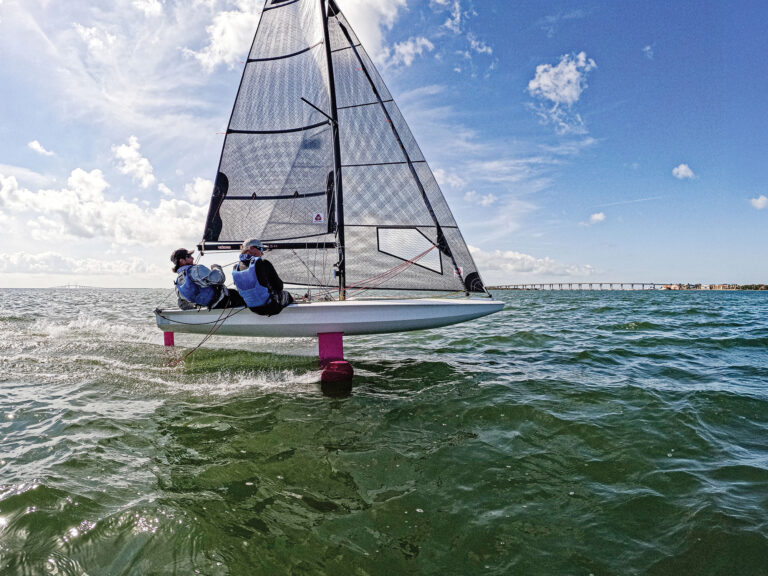
At a recent coed Grandmasters Team Race Regatta, a teammate told me he didn’t understand why there were women-only sailboat races—as if to say, what’s the point? His comment was a brave one in today’s “woke” world, but it’s something that men and women alike probably think about a lot more than they talk about. Yet it raises a valid conundrum as our predominantly male sport pushes toward wider female inclusion: Why isolate women to their own sideshows when the long-term goal is organic integration across the sport?
As I listened to his comments, many of which I’ve heard before, I thought about the fact that several signature women’s events, like the International Women’s Keelboat Regatta and the Santa Maria Cup, are either dead or not as popular as they once were. And later, as I reflected on our discussion, I took stock of our competitors at the Newport Harbor YC Palmer Trophy. Eight of the 54 sailors—15 percent—were women.
“It’s important to have this dialogue,” says Nicole Breault, the first woman to earn St. Francis YC’s Yachtsman of the Year. Breault is a one-design champion and currently competing in the revived Women’s World Match Racing Tour. “Segregation,” she says, “is part of the process of developing a deeper talent pool among women.”
And in a coed environment, she adds, women may defer to men to take leadership roles or are simply pushed aside. “When you remove men from a group, women assert themselves more, show more initiative, and don’t step back to allow the role to be filled by a man.”
Women’s racing also offers opportunities that don’t always happen on coed teams, says Kim Ganley, rear commodore at New York’s Rochester YC and a veteran of the club’s women’s racing program. “When all women are on a boat, every position is open to a woman,” she says. “And when a women’s regatta encourages female race officials, the opportunities expand even further.”
Such opportunities, or the lack thereof, are the common sentiment I hear when having this discussion with other women sailors. Cory Sertl, World Sailing vice president, experienced this firsthand as a youth sailor. “My brother would get invited as a 14-15-year-old, and I never got an invite,” she says. “I was more excited about it than he was, and he was two years younger, but I was never invited. They never thought of me.”
Opportunity is also the driver behind one of the most popular events on San Diego YC’s regatta calendar. The annual Women’s Winter Invitational Regatta was first held in 2018 with a simple goal of encouraging women to participate in keelboat racing, and it was a hit. The 2023 edition hosted 24 yacht-club teams from across the country, with crews spanning from college sailors to septuagenarians.
The regatta’s co-chair, Jessica Sweeney, says she thought long and hard about the role of women-only events before she agreed to chair it. “Women-only events have a place in the overall sport of racing to do a couple of really important things,” she says. “They create an on-ramp for women that counteracts the prevailing societal narrative—women have messages telling them this isn’t for them. These events create an environment where women can gain mastery in a way that isn’t influenced by the gender dynamic. Many women need a safer place, and this is it for them to gain mastery in competitive sailing and regatta management.”
Sweeney speaks from experience and says she has been “pushed” plenty of times. “To this day, there is one sailor who will still take a line out of my hand while I am hoisting the halyard and physically move me out of the space.”
There’s also something to be said of the camaraderie undoubtedly unique to such events. “The all-women environment is nurturing and fun in a way that men have had for years and years and years,” Sertl says. Breault also appreciates the all-female dynamic. “There is something special that happens, a lot of smiles that happen at the end of a collective experience, among not just teammates but everyone involved.”
The visibility of these events is paramount to bringing awareness to a wide and underappreciated talent pool. As Sweeney notes: “When we create women-only events or crews, we are making it impossible to ignore that women can do this. It becomes impossible to say we don’t get full credit for our contributions.”
Different-size and -shaped people sail boats differently, regardless of gender. As Breault puts it: “There are lots of ways to objectify a sailor for what you need.” Sailors can leverage their physical forms differently. When women sail with other women, it encourages them to sail the boat in a way that works for them.

Renee Mehl, director of the US Naval Academy Offshore Sail Training Squadron, says: “On Heineken (the all-women’s entry in the Whitbread Around the World Race), the loads were huge, and things weighed a
ton. We just threw more
people at it.”
“When we rigged the J/22, it was all about how to set up things for four people so we could have women and people who could be smaller, like our kids at the time,” Sertl says. “It’s all about figuring out the maneuver and how to make things efficient with the people you have. Brute strength is helpful, and if you don’t have it, double up, work purchases, make things easier.”
Younger women, like Sarah Alexander, a skipper from Annapolis in the Snipe and J/80 classes, have been a source of new growth in the sport. The J/105 class, for example, with the leadership of Breault and others, recognizes the potential for growth in women and has been funding women’s events throughout North America.
The class sees women as both future boat owners and crew, increasing the long-term value of the boats and the class. The same is true in the J/70 class, which has supported a movement called Mixed-Plus, aimed in its early days to get top female professional sailors into properly paid roles on J/70 teams. The movement has furthered momentum already afoot in other classes.
The IC37, J/105 and Melges 15, for example, now require or incentivize having female crews. At the 2023 Helly Hansen Sailing World Regatta Series in St. Petersburg, Florida, with several Mixed-Plus classes, women made up 15 percent of the registered skippers. In the J/70 class, women were 20 percent of skippers; in the Melges 15, they were 30 percent. It’s a fast trend going in the right direction.
With her experience at US Sailing and World Sailing, Sertl takes a higher view of sailing and says the goal for the good of the sport is to build and attract sailors. “The future of the sport is kids who are 15 to 25 and have the earning power to get involved. Hopefully, as many women and girls as possible,” she says.
“Sponsors today,” she adds, “increasingly want to support events that embrace diversity, inclusivity, fun and sustainability.”
Dawn Riley, a pioneer in women’s sailing, also shares a holistic view of the sport. “All parts of sailing need more people and more sincere efforts to create diversity,” she says, and women are a key part of those numbers and that diversity.
All-women’s events have led to additional efforts to get more women into sailing in integrated ways. Breault and Ganley, for example, have both skippered all-women’s teams in coed events. “That is the frosting on the cake,” Breault says. “Isn’t it great if I can actually sail in open events and also have an all-women’s team without it being an agenda? It’s just what works the best.”
“We won a race last year and were very encouraged and celebrated by male counterparts,” Ganley says. “There are a ton of all-male crews, so what’s the big deal with a boat having an all-female crew?”
In other words, champions will be champions, regardless of gender. Still, Riley says: “Women’s events are relevant conditionally, as long as your goal is to get to the point where they are no longer needed. It might be an indefinite time before we get there, and we might need to circle back and reboot with each new generation.”
In the meantime, she adds, “Mixed teams are the right way to go.”
There were a lot of laughs on the docks at San Diego’s Women’s Winter Invitational and a vibe that makes it special enough that teams hustle for coveted invitations every year. “I didn’t expect that it would be so much fun,” Sweeney says. “I was so gratified to hear from women about the positive experience that we had.”
Having fun is what sailing is all about. If we can all agree on that much, my dear teammate, all-women’s events are more than relevant. I’d say they’re essential.









